Water-Efficient Landscape Gardens in May
Home » Fair Oaks Horticulture Center » WEL Gardens » May in the WEL
The WEL gardens at the Fair Oaks Horticulture Center are open to the public seven days a week from sunrise to sunset for self-guided tours.
Wheelchair accessible, the gardens feature natives, commonly available perennials, trees, shrubs, and plants from other Mediterranean climates that do well with less water during our long, hot, dry summers and tolerate our chilly, damp Sacramento County winters. Most plants are labeled and many are UC Davis Arboretum All-Stars. The landscape demonstrates how home gardeners can be smart about using the water we have to create beautiful landscapes. (For more information see Gardening with Limited Water.)
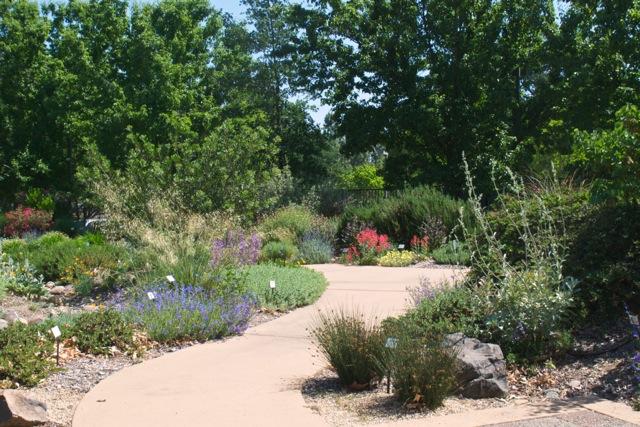
Click here for resources about gardening with limited water.
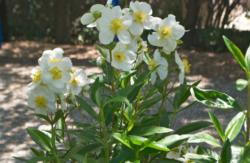
|
Carpenteria californica 'Elizabeth' Carpenteria californica is a beautiful ornamental shrub, displaying lush, white, sweetly scented blooms over several spring and summer months. In fact, it’s hard to believe that it's not an exotic tropical plant rather than a California native that grows wild in a small range in the Sierra. It prefers partial shade and good drainage so we planted it on a slope above the dry creek bed. The Carpenteria in our WEL native garden is especially lovely this spring. |
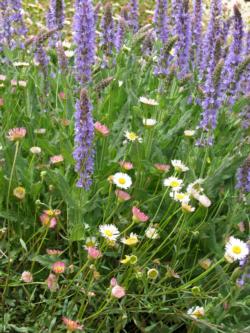
|
Erigeron karvinskianus These low growing, quickly spreading, adaptable perennials (native to Mexico) are covered with cheerful, long lasting, pink tinged small daisy shaped flowers which start blooming in spring. If sheared back, they rapidly rebloom. They may aggressively spread, but are easily removed. They do best in well drained, sunny locations but will accept some shade and require little water. (In the photo they are paired with Salvia nemorosa, another long blooming, drought tolerant perennial with spiking 2 foot lavender flower stalks.) |
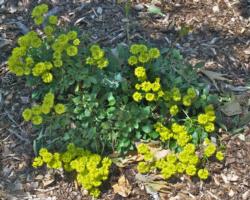
|
Eriogonum umbellatum var. polyanthum This native of Northern California mountain areas adapts well to our climate and soil. It grows as a mounding small semi-evergreen subshrub 1 1/2 feet tall to 3 feet wide. The bright yellow pom-pom like spring blossoms dry to a long lasting sulfur colored seed head. It can tolerate some shade and prefers good drainage. |
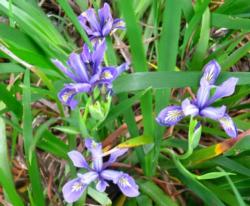
|
Iris douglasiana Pacific Coast hybrid irises are the descendants of years of hybridizing (by plant breeders since the 1920s) using the wild iris, Iris douglasiana, found primarily along the coast from southwestern Oregon south to Santa Barbara. Many of these hybrids grow well with little maintenance in well drained soil, with low summer water and shade from the hot afternoon summer sun. The white "Canyon Snow' is a UC Davis Arboretum All-Star. |
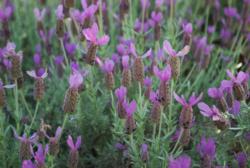
|
Lavandula stoechas 'Otto Quast' Spanish lavender
This showy, shrubby lavender, thrives in our sunny, dry climate. A favorite of bees, butterflies and other beneficial insects, it starts blooming in early spring.
|
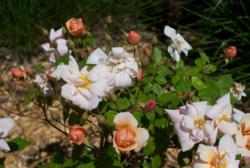
|
Rosa 'Perle d'Or' This relatively thornless, evergreen, polyantha rose shrub does very well in Sacramento gardens. Once established it blooms nearly year round and is very drought tolerant. While it can grow quite large, it can be pruned in the winter to shape. |
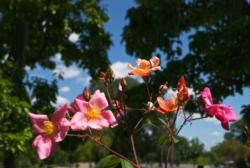
|
Rosa x odorata 'Mutabilis'
The Butterfly rose,
Rosa x odorata 'Mutabilis', is a large shrub rose that's a
UC Davis Arboretum All-Star for good reason. First noted by European botanists in 1896, it likely originated in China. It blooms nearly year round and attracts bees and other beneficial insects. It does well with less water, and tolerates our soils. This rose can tolerate some shade, but it does not do well in windy sites. Blooms begin as scarlet buds and mutate progressively into light yellow, pink, then crimson blossoms (that some have likened to butterflies). New canes are deep red, complementing the flowers and the lush foliage. Nearly maintenance free,
Mutabilis can be pruned in winter to keep the plant more compact.
|



